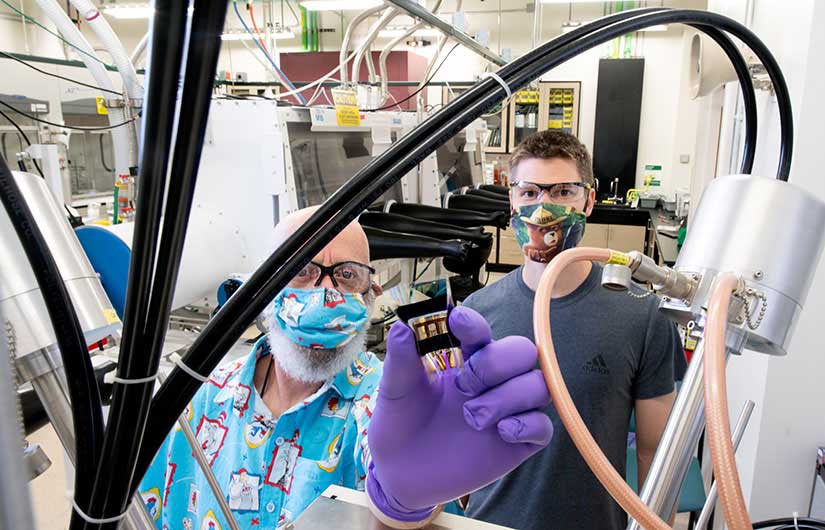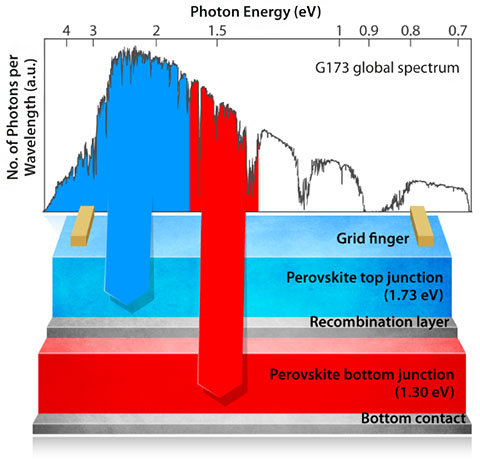Apex Flex: An All-Perovskite Tandem Technology Suitable for Solar-Powered Vehicles

While single-crystal silicon holds a majority of the market share for photovoltaic (PV) solar cell sales, perovskite cells hold at least as great a share in market excitement. Their efficiency continues to climb, and costs continue to fall. Their use in flexible, high-power producing panels could outshine other materials, and with a manufacturing time and cost easily besting competitors’.
But that future is contingent on a perovskite puzzle—how to create stable, full-perovskite tandem cells. Now, an NREL team led by David Moore and Axel Palmstrom has found the final two pieces to the puzzle.
NREL’s new perovskite material, marketed as Apex Flex, broke through two design barriers to arrive at a solar cell that is flexible and stable enough for car-top application at a cost 200 times less than flexible PV technologies of similar specific power. In doing so, Apex Flex realizes the full benefits of perovskite materials—low-cost, high production rate, and high specific power—as a tandem cell that layers two perovskite materials with a combined efficiency higher than any other thin-film technology outside of III-V materials.

“The demonstration of high specific power, flexible PV, with the cost and throughput of solution processes, is a great outcome,” said David Moore, NREL scientist and co-creator of Apex Flex. “But the greatest part of this project is the opportunity to work with the best PV scientists in the world; not just the perovskite researchers, but from all of the PV technologies that help and inform what we do.”
The puzzle pieces that NREL’s team discovered were helpful in overcoming design bottlenecks, which had previously restricted perovskite tandems to dependence on silicon (and thus inflexible), or under-performance in efficiency, caused by chemical instability in the cells.
Part of the puzzle involved a new wide-bandgap perovskite layer, able to withstand heat, light, and operational tests, while providing a reliable and high voltage. The bottleneck in previous designs related to material instability—light would cause chemical segregation within the material and a resulting breakdown in efficiency. The Apex Flex team overcame this issue by altering the layer’s crystal structure using a different molecular alloy. Their result: a continuously tunable bandgap cell with high stability and efficiency.
Naturally, the final piece of the puzzle involved connecting the team’s new wide-bandgap perovskite. Between the two perovskite materials, NREL’s team engineered a new recombination layer while retaining common architectures and manufacturing paradigms. In previous designs, the interconnection region contained small shunt paths that reduced efficiency. Rather than replace current approaches, the NREL team got creative. Through some thoughtful changes to the manufacturing, NREL created a dense and thin recombination layer that eliminates shunt paths and is around 80% thinner than previous technologies.
A detailed account of both breakthroughs was published in the Joule article “Enabling Flexible All-Perovskite Tandem Solar Cells.”

“Pairing more than one metal halide perovskite absorber in a single solar cell enables a truly differentiated solar technology that is high-efficiency, low-cost, and lightweight,” said fellow co-creator and NREL scientist Axel Palmstrom. “This collaborative effort has brought all-perovskite tandems closer to commercial reality, and we are excited to see their real-world applications in the near future.”
Together, NREL’s missing pieces have made a new sort of perovskite cell available. Outside of III-V (spaceship-quality) cells, Apex Flex introduces the only continuously adjustable bandgap cell, the highest potential efficiency cell (37%), and the highest reported efficiency for thin film (24.5%). Apex Flex can be manufactured with high-speed, roll-to-roll methods and is projected to have the highest production rate among competitors. Compared to its only performance-based competitor, III-V materials, Apex Flex is 200-times lower cost.
Apex Flex has resulted in two patent applications that were quickly licensed for commercialization by Swift Solar, which sees opportunity to apply the lightweight and efficient cells in trucking and electric vehicle industries, in addition to broad grid deployment.
The future of wearable and flexible solar panels could truly start with Apex Flex. And like all perovskites, it has much opportunity to grow. While Apex Flex already produces 10 times as much power as current flexible PV technologies, at a lower cost, its potential efficiency is still higher. Conversely, the 25–30-year lifetime required for residential or utility PV systems is currently beyond the reach of Apex Flex. But the strides in stability described above have introduced Apex Flex to the market of vehicular application, and follow-on innovations could take tandem perovskites further.
Learn more about the perovskite research at NREL.
Last Updated May 28, 2025
